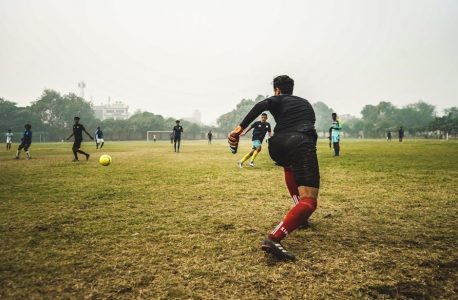Soccer goalkeepers play a crucial role in preventing goals and organizing defense. They must adhere to specific rules, such as the six-second ball handling limit and restrictions on picking up direct passes from teammates. Their unique responsibilities include wearing distinctive uniforms and maintaining ball distribution efficiently while following FIFA regulations to ensure fair play and prevent time-wasting.
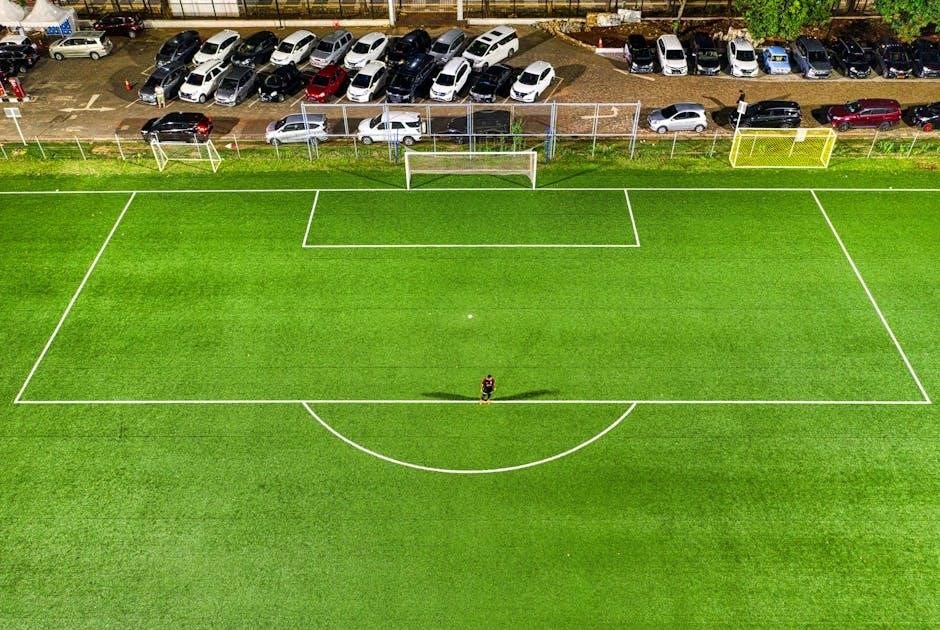
Key Responsibilities of a Soccer Goalkeeper
Soccer goalkeepers are essential for preventing goals and organizing defense. They must stay alert, communicate with teammates, and efficiently distribute the ball while adhering to rules like the six-second limit and proper ball handling techniques.
Preventing Goals
The primary responsibility of a soccer goalkeeper is to prevent the opposing team from scoring by defending the net. This involves making saves, blocking shots, and intercepting crosses. Goalkeepers must stay alert and position themselves strategically to anticipate opponents’ moves. During penalty kicks, they must remain on the goal line until the ball is struck. They also play a crucial role in organizing the defense and directing teammates to reduce scoring opportunities. Effective communication and quick reflexes are essential for success in this role; Additionally, goalkeepers must adhere to rules such as the six-second limit for holding the ball, ensuring they distribute it quickly to maintain gameplay flow. Their ability to protect the goal is vital to the team’s success and overall performance.
Distributing the Ball
After gaining possession of the ball, goalkeepers are responsible for distributing it to teammates efficiently. They must release the ball within six seconds, either by throwing, rolling, or kicking it. Goalkeepers can use their hands or feet to distribute the ball, but they cannot pick it up if it was passed directly by a teammate. Proper distribution is crucial for initiating attacks and maintaining possession. Goalkeepers must avoid time-wasting, as holding the ball too long can result in a corner kick for the opposing team. Effective distribution requires good decision-making and accuracy to find open teammates. This role transitions the team from defense to offense, making it a critical aspect of a goalkeeper’s duties. Adhering to these rules ensures smooth gameplay and minimizes interruptions, while also preventing opponents from gaining unnecessary advantages.
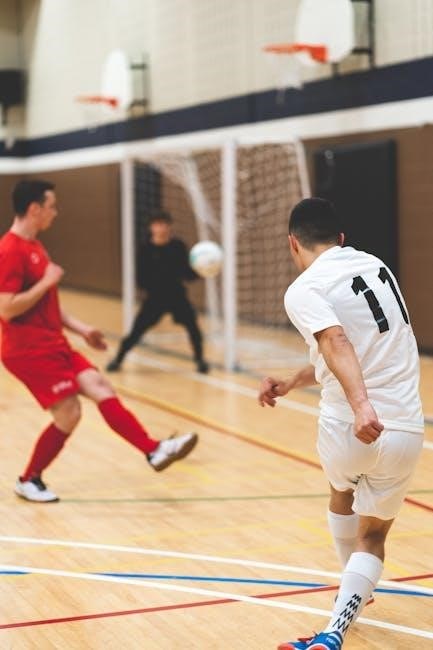
Equipment Requirements for Goalkeepers
Goalkeepers must wear long socks, shin guards, and soccer cleats. FIFA regulations require their uniforms to be distinctive from other players, ensuring visibility and adherence to safety standards during matches.
Essential Gear
Goalkeepers require specific gear to perform effectively and safely. Essential items include long socks to cover shin guards, which are mandatory for protection. Soccer cleats provide stability on the field, while gloves are crucial for grip and ball control. Additionally, goalkeepers must wear a distinctive jersey and shorts to differentiate themselves from other players. Protective gear like padded pants and a goalkeeper jersey with elbow protection is also recommended. The gear must meet FIFA regulations, ensuring safety and fairness in play. Proper footwear, such as cleats, aids in quick movements and sharp turns. The goalkeeper’s gear is designed to balance protection with mobility, enabling them to perform their duties without hindrance. Adhering to these gear requirements is vital for both performance and compliance with the rules of the game.
FIFA Regulations
FIFA regulations for goalkeepers are designed to ensure fair play and maintain the integrity of the game. Goalkeepers must adhere to strict guidelines, such as the six-second rule, which mandates they release the ball within six seconds of gaining possession. Additionally, goalkeepers are prohibited from handling the ball if it is deliberately kicked or thrown to them by a teammate using their feet. This rule aims to prevent time-wasting and promote continuous play. Recent updates to FIFA regulations include an eight-second limit for goalkeepers to release the ball, with failure to comply resulting in a corner kick for the opposing team. These regulations are enforced to enhance the flow of the game and prevent unnecessary delays. By adhering to these rules, goalkeepers play a crucial role in maintaining the balance and fairness of soccer matches worldwide.
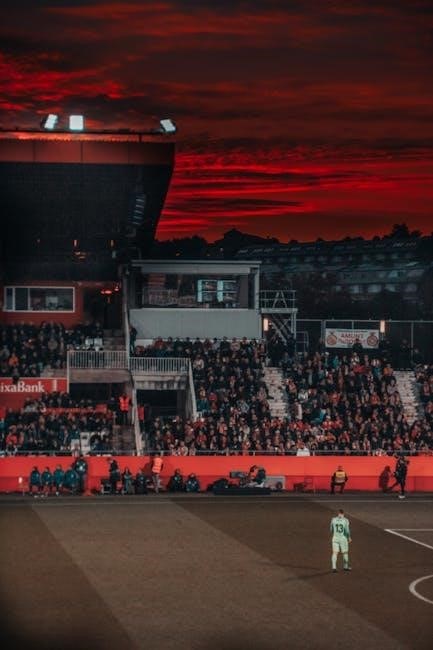
Ball Handling Rules
Goalkeepers must release the ball within six seconds of gaining possession and cannot handle it if it is deliberately kicked or thrown by a teammate, ensuring fair play and continuous action.
Six-Second Rule
Goalkeepers are required to release the ball within six seconds of gaining possession, ensuring the game maintains its flow. Once the ball is in their hands, they must either kick or throw it to a teammate within this timeframe. If they fail to do so, the opposing team is awarded a corner kick, as per recent rule changes implemented by the International Football Association Board (IFAB). This regulation aims to prevent time-wasting and keep the game dynamic. Additionally, goalkeepers cannot hold the ball for extended periods, even if they are within the penalty area. The six-second rule applies universally, from youth leagues to professional matches, emphasizing fair play and consistent enforcement across all levels of soccer.
Using Feet
Goalkeepers are required to use their feet when the ball is passed directly to them by a teammate. This rule ensures the game flows smoothly and prevents unnecessary delays. If a goalkeeper receives a direct pass from a teammate, they must use their feet to play the ball rather than handling it with their hands. This regulation is crucial for maintaining fair play and preventing time-wasting tactics. Goalkeepers are expected to have strong footwork skills to distribute the ball effectively to their teammates. FIFA regulations emphasize that failure to use feet in such situations can lead to indirect free kicks for the opposing team. This rule is consistently enforced across all levels of soccer, from youth leagues to professional matches, to ensure the game remains dynamic and fair for all players involved.
Handling Restrictions
Goalkeepers are restricted from handling the ball with their hands in certain situations. Specifically, they cannot pick up the ball if it has been deliberately kicked or thrown to them by a teammate. This rule prevents time-wasting and ensures the game flows naturally. Additionally, goalkeepers are only permitted to handle the ball within their own penalty area. If they touch the ball with their hands outside this zone, it results in a foul. These restrictions are designed to maintain fair play and prevent unfair advantages. Violations of these rules can lead to indirect free kicks for the opposing team. Understanding and adhering to these handling restrictions is essential for goalkeepers to perform their duties effectively while following the game’s regulations.
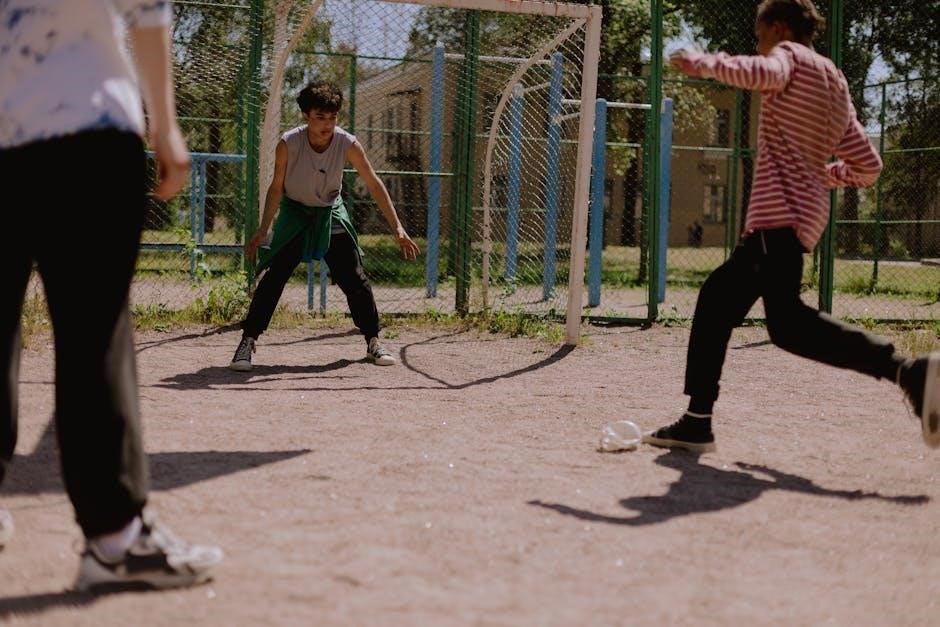
Positioning and Movement
Goalkeepers must position themselves strategically, staying on the goal line and moving side-to-side to anticipate shots. They should time their movements to align with the game’s flow.
Staying on the Goal Line
Goalkeepers are required to stay on the goal line during specific moments of the game, particularly when a penalty kick is being taken. This rule ensures fairness and prevents the goalkeeper from gaining an unfair advantage by moving too early. The goalkeeper must remain stationary, with at least one foot on the goal line, until the ball is struck. Failure to comply can result in a foul or the penalty kick being retaken. This rule is crucial for maintaining the integrity of the game and ensuring that all players adhere to the same standards. By staying on the goal line, the goalkeeper can focus on reacting to the shot once it is taken, rather than anticipating the ball’s movement prematurely. This positioning is a key aspect of a goalkeeper’s role in maintaining defensive discipline.
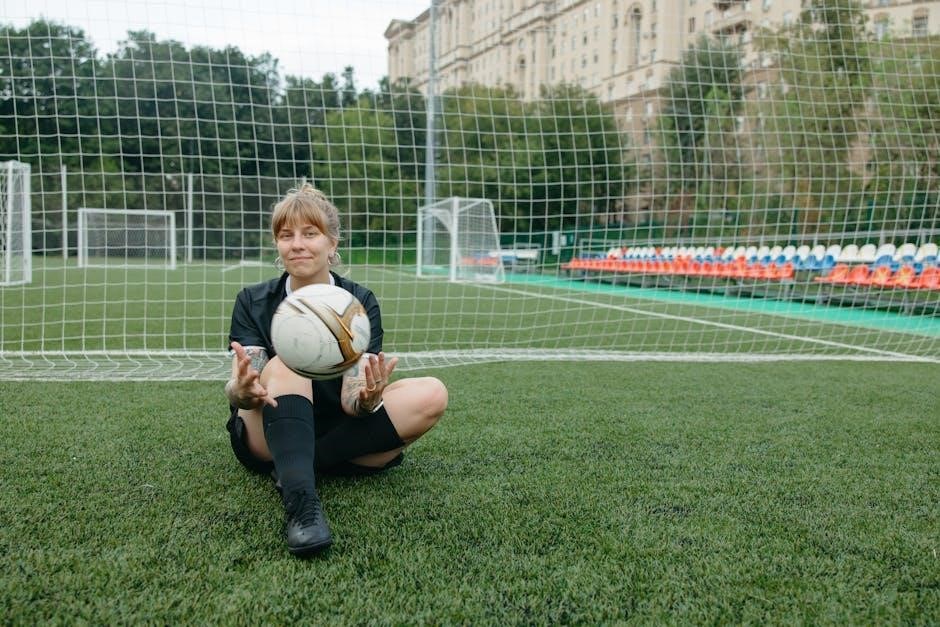
Moving During Play
Goalkeepers have the freedom to move within the penalty area during open play, allowing them to position themselves strategically to anticipate shots or crosses. They can move side-to-side along the goal line or advance into the penalty area to intercept passes or clearances. However, specific rules govern their movement to ensure fair play. For instance, goalkeepers are not permitted to hold the ball for more than six seconds, a rule designed to prevent time-wasting and maintain the flow of the game. If a goalkeeper violates this rule, the opposing team may be awarded an indirect free kick. Additionally, goalkeepers must remain within the boundaries of the penalty area when handling the ball, although they can move freely during open play to coordinate with their team’s defense. These regulations balance the goalkeeper’s mobility with the need for fair and dynamic gameplay.
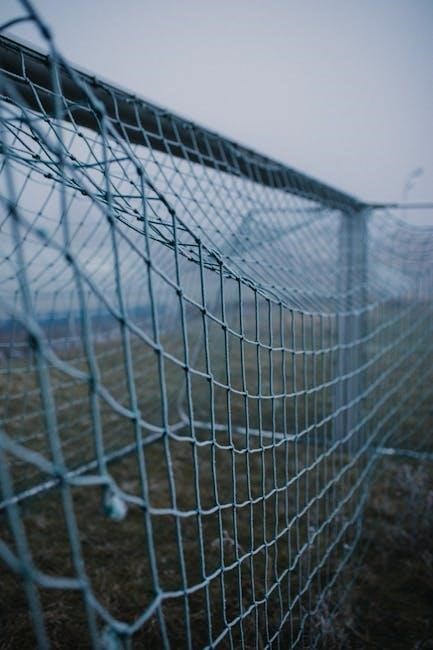
Rules During Specific Plays
During goal kicks, the ball must be placed in the goal box. For penalty kicks, goalkeepers must stay on the line until the ball is kicked. Free kicks require goalkeepers to remain in the penalty area if the ball is within it. Corner kicks allow goalkeepers to move freely but prohibit handling the ball with hands if kicked directly from the corner.
Goal Kicks
A goal kick is taken when the ball leaves the field over the goal line and was last touched by a player from the attacking team. The ball must be placed in the goal box, and the goalkeeper is responsible for ensuring the kick is taken correctly. The goalkeeper must stay on the goal line until the ball is kicked. Once the ball is in play, the goalkeeper can move freely but cannot touch the ball with their hands if it is kicked directly to them outside the penalty area. The goalkeeper’s role is to prevent the opposing team from scoring during this restart, making their positioning and awareness critical. Proper execution of goal kicks is essential for maintaining offensive and defensive balance in the game.
Penalty Kicks
A penalty kick is awarded when a foul occurs inside the penalty area. The goalkeeper must remain on the goal line, between the posts, until the ball is kicked; They cannot move forward until the ball is struck. The ball must be placed on the penalty spot, and the goalkeeper can only dive or move laterally along the line. Once the ball is kicked, the goalkeeper can try to save it or defend against rebounds. If the ball is missed or saved, play resumes, and the goalkeeper can use their hands to control the ball if it remains in the penalty area. However, if the ball is kicked outside the penalty area, the goalkeeper must use their feet to play the ball. Proper positioning and anticipation are critical for goalkeepers during penalty kicks, as they aim to prevent the opposing team from scoring. The rules ensure fairness and maintain the integrity of the game.
Free Kicks
In soccer, free kicks are awarded to the attacking team after a foul by the defending team. The ball is placed at the spot of the foul, and play is restarted. For a direct free kick, the ball can be kicked directly into the goal, while an indirect free kick requires another player to touch the ball before a goal can be scored. The goalkeeper must stay on the goal line until the ball is kicked and can only use their hands within the penalty area. For direct free kicks, the goalkeeper may position themselves to anticipate the shot, while for indirect kicks, they often stay put or organize the defense. The goalkeeper must remain vigilant to prevent quick restarts and communicate with the wall to cover angles effectively. Proper positioning and awareness are essential for goalkeepers during free kicks to prevent scoring opportunities for the opposing team.
Corner Kicks
During a corner kick, the ball is placed in the corner arc nearest to where it went out of bounds. The goalkeeper must stay on the goal line until the ball is kicked. They can use their hands only within the penalty area. The goalkeeper’s role is to protect the net and communicate with defenders to manage the situation. Recent rule changes, such as the eight-second limit for holding the ball, apply to corner kicks as well. If the goalkeeper holds the ball beyond this time, a corner kick may be awarded to the opposing team. Proper positioning and anticipation are key for goalkeepers to defend against scoring opportunities from corner kicks effectively.
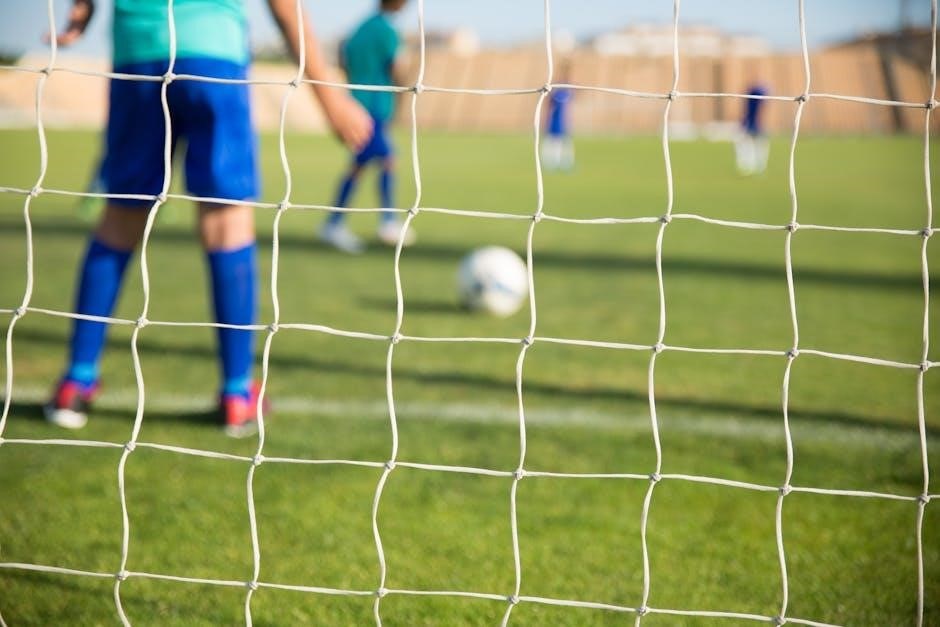
Additional Regulations
Additional regulations include preventing time-wasting by limiting ball possession to six seconds and ensuring goalkeepers wear distinctive uniforms. Handling restrictions also apply to maintain fair play.
Time-Wasting Prevention
Goalkeepers are subject to strict time limits to prevent unnecessary delays. Once in possession of the ball, they must release it within six seconds by either throwing or kicking it to a teammate. This rule aims to maintain the flow of the game and reduce stoppages. If a goalkeeper exceeds the time limit, the opposing team is awarded a corner kick, as recently introduced by the International Football Association Board (IFAB). This regulation ensures that goalkeepers cannot hold the ball excessively, promoting faster gameplay and fair competition. Compliance with this rule is essential for maintaining the integrity and pace of the match.
Uniform Distinctiveness
Goalkeepers are required to wear uniforms that are visually distinct from both their teammates and the opposing team. This includes long socks, shin guards, and soccer cleats, all of which must meet FIFA regulations. The goalkeeper’s attire must be easily identifiable to avoid confusion during play. FIFA mandates that the goalkeeper’s equipment, including gloves and jersey, must differ in color and design from other players and the referee. This rule ensures clarity for players, officials, and spectators alike, helping to maintain order and fairness in the game. The distinctive uniform also allows for quick identification of the goalkeeper’s position on the field, which is crucial for enforcing rules related to ball handling and positioning.
The role of a soccer goalkeeper is both demanding and essential, requiring a blend of physical skill, mental focus, and adherence to specific rules. From preventing goals to distributing the ball, the goalkeeper’s responsibilities are multifaceted. Equipment requirements, such as distinctive uniforms and specialized gear, ensure safety and fairness. Rules like the six-second handling limit and restrictions on direct passes from teammates maintain game flow. Positioning and movement guidelines, along with regulations during specific plays like penalty and goal kicks, further define the goalkeeper’s role. Additionally, measures to prevent time-wasting and ensure uniform compliance highlight the complexity of the position. By understanding these rules, goalkeepers can perform effectively, contributing to their team’s success while upholding the integrity of the game at all levels.

